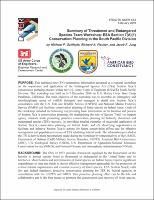Please use this identifier to cite or link to this item:
https://hdl.handle.net/11681/32312Full metadata record
| DC Field | Value | Language |
|---|---|---|
| dc.contributor.author | Guilfoyle, Michael P. | en_US |
| dc.contributor.author | Fischer, Richard A., Jr., 1964- | en_US |
| dc.contributor.author | Jung, Jacob F. | en_US |
| dc.creator | Dredging Operations and Environmental Research Program (U.S.) | en_US |
| dc.creator | Environmental Laboratory (U.S.) | en_US |
| dc.date.accessioned | 2019-03-07T15:05:38Z | en_US |
| dc.date.available | 2019-03-07T15:05:38Z | en_US |
| dc.date.issued | 2019-02 | en_US |
| dc.identifier.govdoc | ERDC/TN DOER-E43 | en_US |
| dc.identifier.uri | https://hdl.handle.net/11681/32312 | en_US |
| dc.identifier.uri | http://dx.doi.org/10.21079/11681/32312 | en_US |
| dc.description | Technical Note | en_US |
| dc.description.abstract | This technical note (TN) summarizes information presented at a regional workshop on the importance and application of the Endangered Species Act (ESA) Section 7(a)(1) conservation planning process within the U.S. Army Corps of Engineers (USACE) South Pacific Division. This workshop was held on 6-7 December 2016 on U.S. Marine Corps Base Camp Pendleton, California. The main objective of the workshop was to assemble an interagency and interdisciplinary group of wildlife biologists and managers to detail how Section 7(a)(1) consultation with the U.S. Fish and Wildlife Service (USFWS) and National Marine Fisheries Service (NMFS) can facilitate conservation planning of listed species on federal lands. Goals of this workshop included the following: (a) providing basic information on the function and process of Section 7(a)(1) conservation planning, (b) emphasizing the role of Section 7(a)(1) to support agency missions while promoting proactive conservation planning for federally threatened and endangered species (TES) recovery, (c) providing detailed examples of successful application of Section 7(a)(1) conservation planning on federal lands, and (d) identifying opportunities to facilitate and improve Section 7(a)(1) actions for future conservation efforts and for effective management and population recovery of TES inhabiting federal lands. The information provided in this TN is derived from presentations made during the workshop by representatives of the USACE, Department of Defense (DoD) Military Service Branches, USFWS, American Bird Conservancy (ABC), U.S. Geological Survey (USGS), U.S. Department of Agriculture-National Resources Conservation Service (NRCS), and National Oceanic and Atmospheric Administration (NOAA). | en_US |
| dc.description.sponsorship | Dredging Operations and Environmental Research Program (U.S.) | en_US |
| dc.format.extent | 31 pages/1.245 Mb | en_US |
| dc.format.medium | PDF/A | en_US |
| dc.language.iso | en_US | en_US |
| dc.publisher | Engineer Research and Development Center (U.S.) | en_US |
| dc.relation.ispartofseries | Technical Note (Dredging Operations and Environmental Research Program (U.S.)) ; no. ERDC/TN DOER-E43 | en_US |
| dc.rights | Approved for Public Release; Distribution is Unlimited | en_US |
| dc.source | This Digital Resource was created in Microsoft Word and Adobe Acrobat | en_US |
| dc.subject | Environmental protection | en_US |
| dc.subject | Environmental management | en_US |
| dc.subject | Endangered species | en_US |
| dc.subject | Dredging Operations and Environmental Research Program (U.S.) | en_US |
| dc.title | Summary of threatened and endangered species team workshop: ESA Section 7(A)(1) conservation planning in the South Pacific Division | en_US |
| dc.type | Report | en_US |
| Appears in Collections: | Technical Note | |
Files in This Item:
| File | Description | Size | Format | |
|---|---|---|---|---|
| ERDC-TN DOER-E43.pdf | ERDC/TN DOER-E43 | 1.28 MB | Adobe PDF |  View/Open |